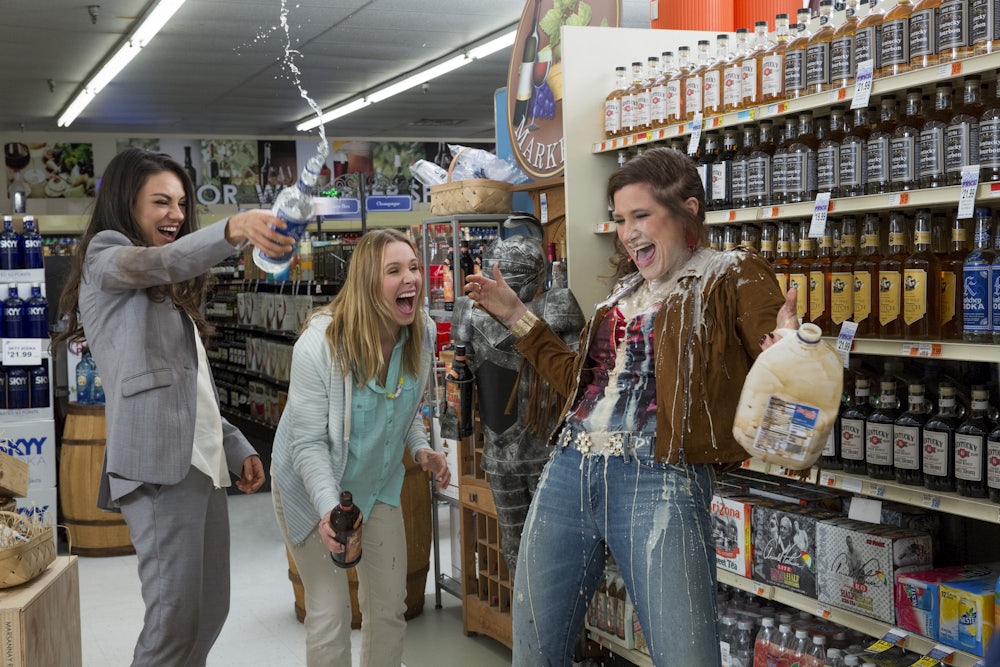Bad Moms opens with a bird-eye view of rows of suburban houses, each with perfectly-mowed lawns, and walls so fresh the paint seems almost wet. One of these houses is the home of Amy, a perfectionist, overworked mother (Mila Kunis) surrounded by children. She works at a coffee roasting company where her millennial co-workers took two weeks off when Jon Snow died on Game of Thrones. Her husband, whom she calls her third child, is exhausted after handling two conference calls a day. And then of course, there are her actual children, who she brings to school with perfectly packed lunch boxes containing sandwiches with peanut butter, without the peanuts.
Yet Amy can’t escape the follies of youth, and Bad Moms truly gets started after the kids are out of sight. Amy is approached by a clique of PTA-moms led by Gwendolyn (Christina Applegate), the bossy, mean mom at school who determines which ingredients can be used for the bake sale (almost nothing) to which teachers get to keep their jobs (no one who stands in her way). She is accompanied by uptight Stacy (Jada Pinkett Smith), and minion Vicki (Annie Mumolo), who isn’t the brightest crayon in the box. A series of spaghetti and cam-sex filled incidents drives Amy and fellow moms Kiki (Kristen Bell) and Carla (Kathryn Hahn) to the brink, and they decide to go on a quest to liberate themselves from their domestic demands and bring down the ruling PTA-clique.
The movie has been criticized, and rightfully so, for its failure to portray motherhood faithfully: These are upper-middle class parents who can afford to pay nannies, and their children are shoved off-screen whenever it’s convenient. Men, people of color, and animals are used as props, as they seem to have no place in a school that holds gluten-free bake sales. The movie’s writers, Jon Lucas and Scott Moore of Hangover fame, seem to say that the real problem for women is vengeance and jealousy amongst mothers, rather than the structural sexism that still defines parenting-roles today.
But Bad Moms shouldn’t be seen as a movie about motherhood, though no doubt many mothers will visit the cinema in search for a sense of camaraderie. Instead, Bad Moms should be considered as the latest iteration in a long legacy of clique movies like Heathers, Clueless and Mean Girls—the moms here are simply girls who have graduated high school. Or have they? An outsider, in this case Amy, emerges to challenge the throne of the Queen Bee, Gwendolyn, whose face is composed to the point of bursting. The usual prom queen trope is now replaced by Amy’s quest to get elected as the next president of the PTA, while the heartthrob in this context is a hot widower who turns heads, but isn’t expected to attend the PTA-meetings—men aren’t supposed to do a mother’s job, even if the mother is no longer with us. There’s a clear Mean Girls reference hidden in one of the last scenes—when the PTA-attendees start to confess their “bad” mothering, one woman stands up and admits she’s not even a mom, she’s simply there because she’s lonely.
Even though Mean Girls is often applauded for speaking to the “real” experience of high school, I doubt that there are many high schoolers who believe that Lindsay Lohan looks like them. Bad Moms excels during its most exaggerated moments: when Amy runs through the supermarket with her friends, rips open packages, and throws cornflakes in the air in slow motion, that’s when the signature of the Hangover-series shines. Its least convincing moments are when the movie attempts to be emotionally truthful: the subplot of Amy’s dwindling marriage is even less believable than the bawdy supermarket scene.
But Bad Moms isn’t supposed to be realistic. In the same way that Mean Girls is a caricature of girls and The Hangover is a caricature of boys, Bad Moms is a caricature of mothers. What’s worth asking instead is: When did mothers join the bench of pop-cultural tropes, sitting on the bleachers next to the freaks and geeks? Bad Moms isn’t necessarily about motherhood, the experience, as it about motherhood, the social clique.
The bad in the title doesn’t refer to a value-judgment, but a value-creation. The characters aren’t bad at mothering, instead, they’re accomplished at having a life beyond motherhood, inhabiting a land of strollers in the daylight, opening their homes for house parties at night, and making out with hot widowers. What really emerges out of Bad Moms is a new type of woman: The child and the husband are mere accessories to the type of person a mother she wants to be. Kristen Bell and Kathryn Hahn’s characters give a summary in the movie of the different cliques that the school consists of: the juicing moms, the lesbian moms, the black moms, the black lesbian moms. Motherhood is the oldest job in humanity, yet it’s only recently that it’s become a choice, and with that, a lifestyle.
Bad Moms is for those who want to pay to watch the fantasy of motherhood and ask themselves the question: Which category of mothers do I want to belong to? Protagonists of the clique film usually learn in the final scene that the best way to be popular is to remain the self that they tried to get rid of. At the end of Clueless, Cher finds out she was the one who was “clueless” all along. In Mean Girls, Cady realizes that “calling other people fat won’t make you skinnier.” In Bad Moms, Amy declares that a school should be a place where we “teach our children to be good people.” But it’s telling its moms the exact opposite: being a good mom isn’t popular anymore.
